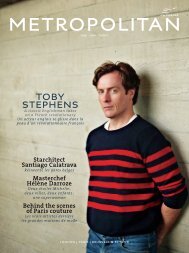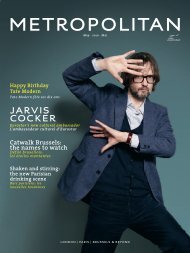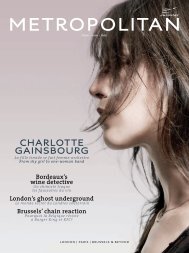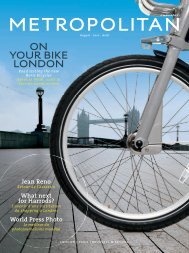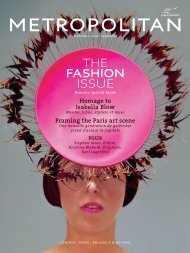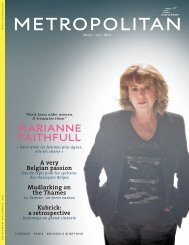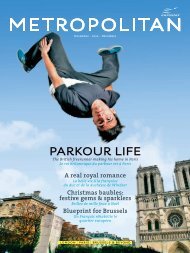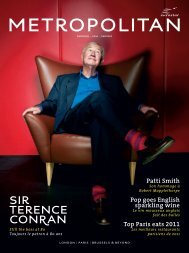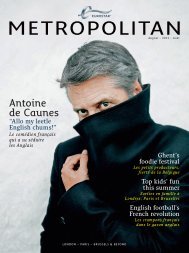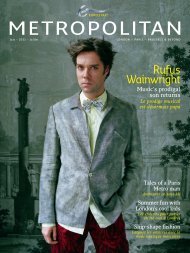november-2010
november-2010
november-2010
Create successful ePaper yourself
Turn your PDF publications into a flip-book with our unique Google optimized e-Paper software.
Nicolas Fouquet, and was outraged to fi nd that a mere subject<br />
possessed such a home. He decreed that his hunting lodge and<br />
lands at Versailles be transformed into a palace and gardens<br />
of unsurpassable magnifi cence, the task entrusted to the<br />
architect and gardeners who had worked on Vaux-le-Vicomte.<br />
But Versailles was a foul-smelling swampland, not at all<br />
suited to the king’s vision of verdant gardens devoted to the<br />
arts. There wasn’t even a natural stretch of water to create<br />
refl ections – an important element in garden design of the<br />
day. Nonetheless, principal gardener André Le Nôtre did not<br />
let the unpromising terrain limit his imagination. Within<br />
months he’d drawn up plans, and squads of gardeners,<br />
labourers and fountain-builders were put to work. Thousands<br />
of tonnes of earth had to be moved, not least in creating the<br />
famous Grand Canal. At one point 36,000 men were on site.<br />
“The king wanted the gardens to symbolise his power and to<br />
show that even Nature had to obey him,” says Baraton.<br />
The results, even four centuries later, are awe-inspiring.<br />
Immediately in front of the palace, formal gardens in the<br />
French style are arranged with mathematical precision to<br />
form a leafy framework within which to show off fountains<br />
and statuary. The smaller châteaux of Grand and Petit<br />
Trianon lie beyond. Further still, among wilder gardens in<br />
the romantic style, is the Normandy-inspired hamlet where<br />
Marie-Antoinette played at being a dairymaid. Today the<br />
estates extend over around 900 hectares.<br />
“In formal gardens in the French tradition the gardener<br />
is an architect. Even the trees don’t have the right to grow,”<br />
explains Baraton. “But in a romantic, English-style garden,<br />
Below: the<br />
cottage built<br />
for Marie-<br />
Antoinette in<br />
her "hamlet"<br />
Ci-dessous :<br />
la chaumière<br />
de Marie-<br />
Antoinette<br />
86 METROPOLITAN<br />
the gardener becomes a poet who creates a vision<br />
of nature with rivers and benches and hidden<br />
nooks – a setting for strolling or romance.<br />
“If you wanted to charm someone<br />
romantically you wouldn’t take them to a formal<br />
French garden like the Tuileries. It’s a corridor.”<br />
Louis XIV was so determined that special<br />
guests would see his gardens in the best possible<br />
play of light and shadow that he composed at least six<br />
different guided walks, dictating step by step how they were<br />
to be viewed. For instance, the tour for Marie-Béatrice d’Este,<br />
second wife of King James II of England, was designed to be<br />
taken on July 19 at 6pm.<br />
Today Le Nôtre, who masterminded many other famous<br />
gardens including Chantilly, remains France’s most<br />
celebrated gardener. At the Tuileries in Paris, as you enter<br />
from the place de la Concorde, a bewigged stone bust of him<br />
can be seen looking out into the gardens.<br />
While visitors from around the world crowd to marvel at<br />
Versailles, its splendours are also a great favourite with the<br />
French. With a twinkle in his eye, Baraton says: “What’s very<br />
amusing is that almost all French people declare themselves<br />
to be republicans and yet the historical monuments they are<br />
most attached to are those which best symbolise royalty.”<br />
Having successfully created a royal residence of unrivalled<br />
opulence, Louis XIV sought to reinforce his infl uence by<br />
harnessing some of the fi nest scientifi c minds of the day.<br />
In 1666 he founded the Académie des Sciences and Versailles<br />
“The French declare<br />
themselves republicans,<br />
yet are most attached to<br />
monuments to royalty”<br />
became a place of learned exchanges. Scientists came to<br />
court as engineers in the army or navy or as tutors to the<br />
princes. This close relationship between academic circles and<br />
the court continued through the reigns of Louis XV and XVI.<br />
A new exhibition, Science and Curiosities at the Court of<br />
Versailles, puts this dynamic under the microscope. Among<br />
the curiosities displayed together for the fi rst time is Louis<br />
XV’s rhinoceros, or rather a stuffed model of the beast which<br />
was shipped in from India and housed in his royal<br />
menagerie, only to meet its end during the Revolution.<br />
From 1784, there’s a remarkable automaton: a lady<br />
dulcimer player who taps out tunes with little hammers (the<br />
mechanism is hidden by her long dress). The Dulcimer Player<br />
was originally presented to Marie-Antoinette. Dating from



